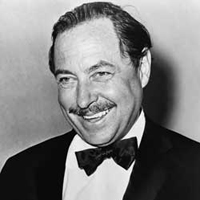Symbolism in The Glass Menagerie
Symbolism is the part and parcel of The Glass Menagerie. We have already known that Tennessee Williams has not succumbed to the temptation of the nineteenth century realism. He was well-aware of the limitations of the 19th century realism. He felt handicapped by the confining power of the 19th century realism.

Tennessee Williams (1911-1983)
So he decided to make that mode of realism flexible by adopting the technique of symbolism. Unlike the l9the century concrete realism Williams's realism is somewhat distinct. Williams's realism is psychological. The Glass Menagerie has striven to bring into light the psychological realism. To give the psychological touch of realism, representation at the literal level is pretty insufficient. That is why, Tennessee Williams had to depend upon the technique of symbolism. In addition, it is the added goal of Williams to capture the reality of illusion. To portray the reality of illusion Williams felt a dire necessity of symbolism. Let's see what some of the symbols, Tennessee Williams used are and how these symbols are inextricably connected with the central theme.
The Glass Menagerie: This symbol retains crucial importance because the play itself is entitled on the basis of this symbol. 'The Glass Menagerie' is the creative product of Laura's defected inferiority. It is through this menagerie that Laura succeeded in defecting her heavy inferiority into the direction of creativity. Typically this symbol for Laura's own innocent way of deflecting inferiority into an admirable outcome to delicate creativity.
The glass Menagerie is also a symbol of isolation. It is a symbol of the artificiality of her handicapped and heavily interiorized creativity. In the same line of interpreting this symbol, it appears to be a symbol of the reality of illusion, which is overtly pleasingly to Laura. In a nutshell, it is a symbol of escapism.
Unicorn: In her glass Menagerie Laura had manufactured a unicorn of glass. This unicorn has one horn only. The unicorn is totally extinct on earth. Laura's existence in the external world is virtually extinct. So, to make her life parallel to her illusionary world, she makes a unicorn which is extinct in the world. The virtual extinction a unicorn is suggestive of the virtual extinction of Laura in the real world. Apart from this, the characteristic of a unicorn, it is easily breakable. The brittleness of the unicorn suggests the fragility of Laura. When this unicorn fell into the hand of Jim O'Connor, it broke at once. This breaking away of the unicorn is illustrative of the emasculation and impotence of Jim O'Conner.
Jim O'Connor: The most practical and realistic character Jim O'Connor is himself a symbolic character. He has been held as an emissary of an external world. For the most part Jim is realistic. In comparison to other characters he is somewhat safe from the danger of illusion. It is he who stressed upon the importance of thinking, acting and living in line with realism. No matter how tall a claim of being realistic, his claim suffers serious defects. To overcome his present difficulties and obstacles, Jim has been choosing new fields like radio-engineering and rhetoric. His choice is practical and realistic. But his overemphasis upon the alchemy of the future is dangerously risky. It is an act of illusion to negate the present with the device of the future. In this regard Jim appears to be an unconscious victim of illusion.
The play is embedded with other minor symbols. The rainbow that comes from the color of Laura's glass menagerie is a symbol of illusion. The blowing out of light is also a symbol of the forthcoming disappointment resulting from the gradual revelation of the fact that Jim O'Connor is a fiancé of some other girl. The setting (Wingfield's house in the urban tenement) is designed to be symbolic of isolation. Amanda's moral platitudes "rise and shine, rise and shine" symbolizes her conviction that moral purity and refinement is a passport to success. The character "Laura" itself is symbolic of the passing freshness and fragile lushness of Laurel. The grinning portrait of Tom's father is symbolic of the embedded memory of betrayal and isolation as reflected in the mind of the character.
The Glass Menagerie Study Center
Nature of illusion in The Glass Menagerie
Dramatic Technique in The Glass Menagerie
Tom as a Representative of the 20th Century Man
Laura as a Romantic Superwoman in The Glass Menagerie
The Glass Menagerie Study Center
Introduction of The Glass Menagerie
Summary of The Glass Menagerie
Sublimating Animal Drives into Aesthetics
Style of Williams in The Glass Menagerie
Biography of Tennessee Williams
 |
bachelorandmaster.com |